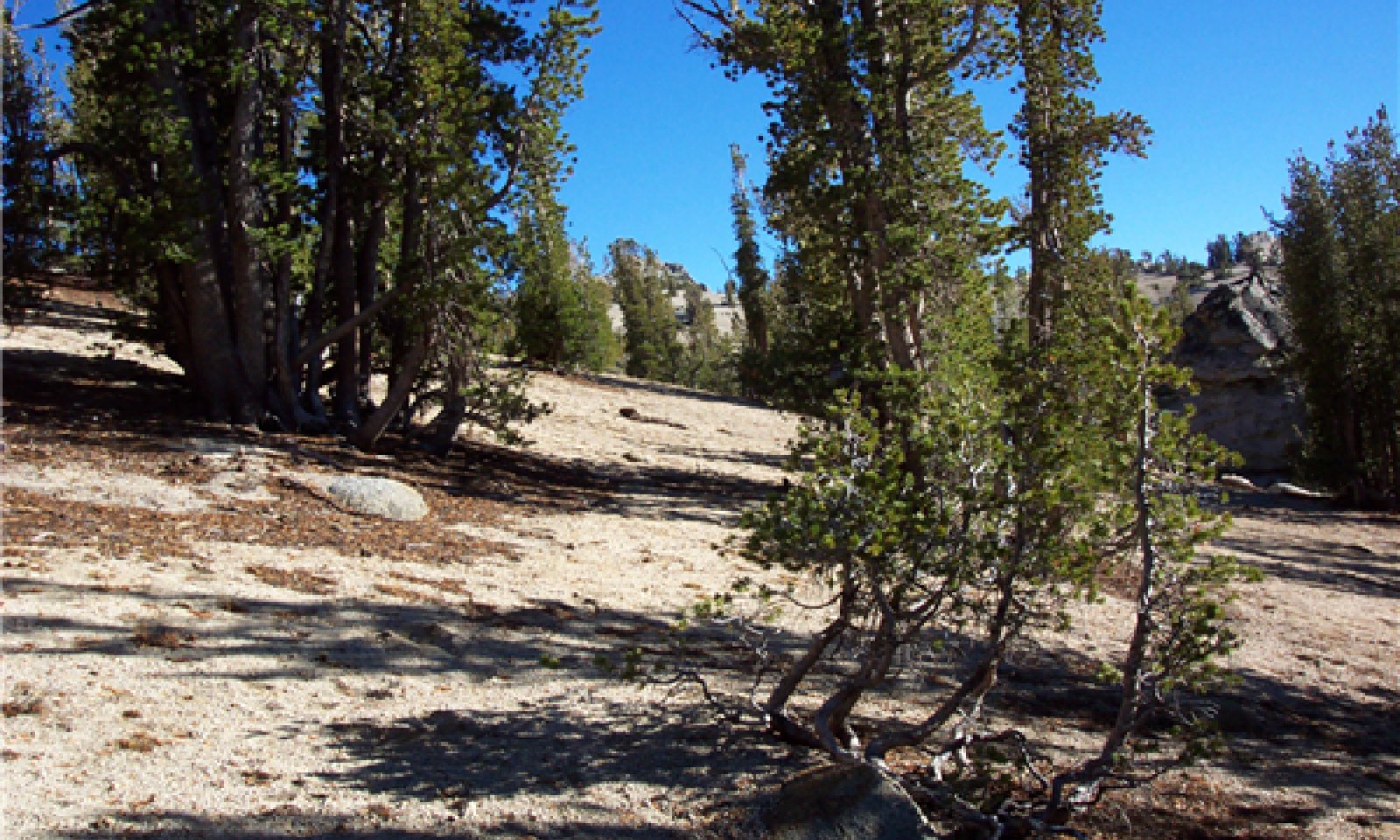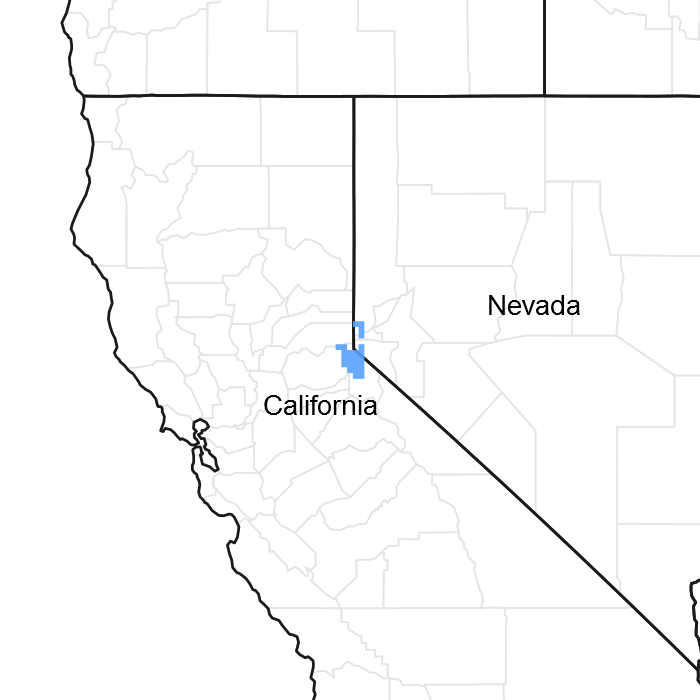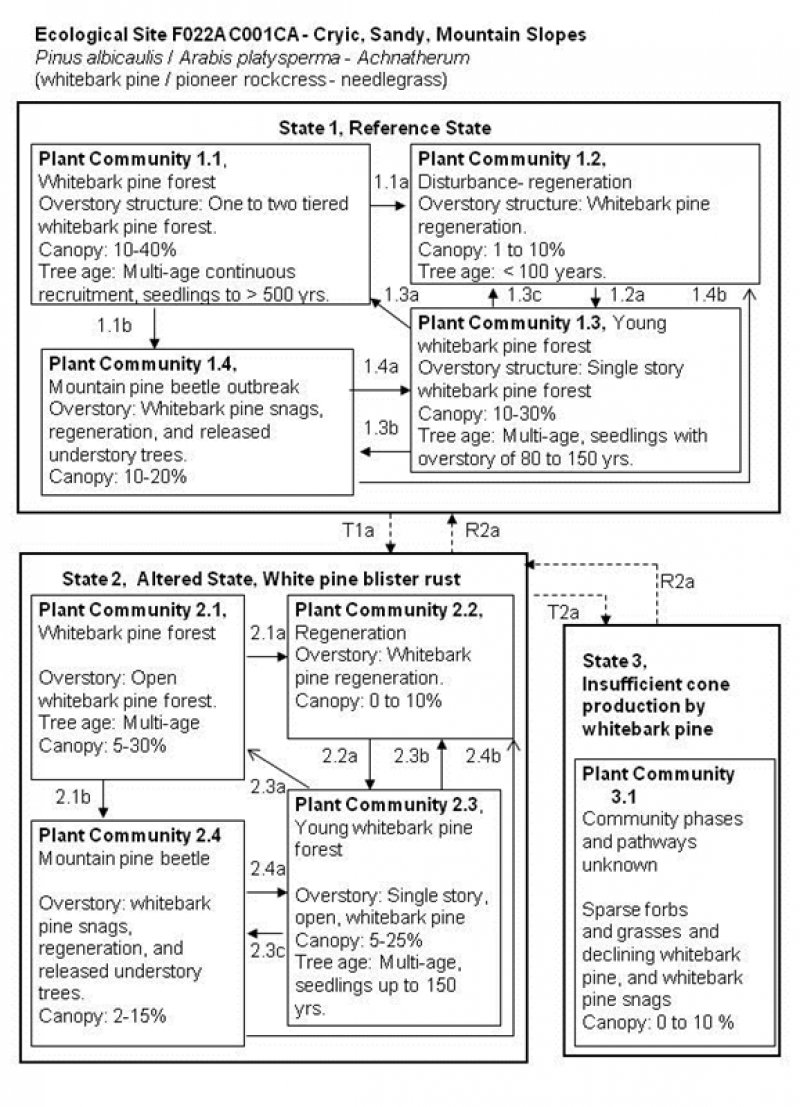

Natural Resources
Conservation Service
Ecological site F022AC001CA
Cryic Sandy Mountain Slopes
Accessed: 04/02/2025
General information
Approved. An approved ecological site description has undergone quality control and quality assurance review. It contains a working state and transition model, enough information to identify the ecological site, and full documentation for all ecosystem states contained in the state and transition model.

Figure 1. Mapped extent
Areas shown in blue indicate the maximum mapped extent of this ecological site. Other ecological sites likely occur within the highlighted areas. It is also possible for this ecological site to occur outside of highlighted areas if detailed soil survey has not been completed or recently updated.
MLRA notes
Major Land Resource Area (MLRA): 022A–Sierra Nevada and Tehachapi Mountains
MLRA 22A
Major Land Resource Area 22A, Sierra Nevada Mountains, is located predominantly in California and a small section of western Nevada. The area lies completely within the Sierra Nevada Section of the Cascade-Sierra Mountains Province. The Sierra Nevada range has a gentle western slope, and a very abrupt eastern slope. The Sierra Nevada consists of hilly to steep mountains and occasional flatter mountain valleys. Elevation ranges between 1,500 and 9,000 ft throughout most of the range, but peaks often exceed 12,000 ft. The highest point in the continental US occurs in this MLRA (Mount Whitney, 14,494 ft). Most of the Sierra Nevada is dominated by granitic rock of the Mesozoic age, known as the Sierra Nevada Batholith. The northern half is flanked on the west by a metamorphic belt, which consists of highly metamorphosed sedimentary and volcanic rocks. Additionally, glacial activity of the Pleistocene has played a major role in shaping Sierra Nevada features, including cirques, arêtes, and glacial deposits and moraines. Average annual precipitation ranges from 20 to 80 inches in most of the area, with increases along elevational and south-north gradients. Soil temperature regime ranges from mesic, frigid, and cryic. Due to the extreme elevational range found within this MLRA, Land Resource Units (LRUs) were designated to group the MLRA into similar land units.
LRU "C" Northern Sierra Subalpine: Elevations are typically between 7,800 and 9,800 feet. The frost free period is between 30 and 90 days, MAAT is between 35 and 44 degrees, MAP is between 45 and 65 inches. Soils are typically cryic, but frigid soils may occur at lower elevations on southern aspects. Forests are dominated by whitebark pine (Pinus albicaulis), Sierra lodgepole pine (Pinus contorta spp. murrayana), mountain hemlock (Tsuga mertensiana) and/or California red fir (Abies magnifica).
Classification relationships
Forest Alliance = Pinus albicaulis – Whitebark pine forest; Association = tentatively Pinus albicaulis/Achnatherum californica (Sawyer, John O., Keeler-Wolf, Todd, and Evens, Julie M. 2009. A Manual of California Vegetation. 2nd ed. California Native Plant Society Press. Sacramento, California.)
Ecological site concept
This ecological site occurs in the highest elevations of the northern subalpine LRU, typically between 9,000 and 10,500 feet on mountain slopes that are typically between 15 and 50 percent. Soils are derived from granitic parent material, and are shallow to moderately deep over paralithic granitic bedrock, with a sandy skeletal particle size class. This site is dominated by whitebark pine (Pinus albicaulis) forest. Cold temperatures and a short growing season restrict the occurrence of less frost resistant conifers. Coarse soils with very low water holding capacity support a minimal understory.
Associated sites
| F022AC002CA |
Cryic Sandy North Apsect Mountain Slopes This ecological site occurs on north aspects and is a mountain hemlock (Tsuga mertensiana) - whitebark pine forest. |
|---|---|
| F022AC003CA |
Frigid-Cryic Sandy Slopes This ecological site occurs at lower elevations and is dominated by California red fir (Abies magnifica)- western white pine (Pinus monticola) forests. |
| F022AC005CA |
Cryic Sheltered, Moist Sandy Mountain Slopes This ecological site occurs on northern aspects on granitic soils. A mixed subalpine forest is present, dominated by mountain hemlock and Sierra lodgepole pine. |
| F022AC007CA |
North-Facing Cryic Loamy Mountain Slopes This ecological site occurs volcanic soils on north facing aspects. A mixed subalpine forest is present composed of mountain hemlock, western white pine, lodgepole pine (Pinus contorta var. murrayana), and California red fir. |
| F022AF004CA |
Frigid, Shallow To Deep, Sandy Mountain Slopes This ecological site occurs on shallow to moderately deep, frigid soils, on southern aspects, with an open Jeffrey pine forest, and montane shrubs. |
| F022AX101CA |
Moist Colluvial Headwater System This ecological site occurs in headwater swales, with quaking aspen (Populus tremuloides) forests dominant. |
| R022AA200CA |
Alpine Scree This ecological site occurs in the alpine LRU, on mountain peaks and ridges, an alpine forb community is dominant. |
| R022AC204CA |
Cryic, Umbric Or Andic Slopes This ecological site occurs on soils with an umbric horizon or volcanic parent material. Mountain sagebrush (Artemisia tridentata spp. vaseyana) and antelope bitterbrush (Purshia tridentat) are dominant. |
| R022AE202CA |
Granitic Pocket This ecological site occurs at the lower elevations on glacially scoured basins and sideslopes. Scattered western juniper (Juniperus grandis) and Sierra lodgepole pine are present, with forbs and grasses. |
| R022AE213CA |
Steep Rubbly Slope This ecological site occurs at the lower elevations on south facing, frigid soils, with a high amount of rubble. Montane shrublands are present, dominated by greenleaf manzanita (Arctostaphylos patula) and whitethorn ceanothus (Ceanothus cordulatus). |
Similar sites
| R022AC200CA |
High Elevation Volcanic Mountain Slopes This ecological site occurs on volcanic soils. Whitebark pine woodlands dominant with a more diverse understory. |
|---|---|
| F022AB112CA |
Gravelly Loamy Slopes This ecological site occurs in the southern subalpine LRU, on moderately deep soils over hard granitic bedrock, and typically has finer surface textures. Whitebark pine woodlands are present. |
| F022AC002CA |
Cryic Sandy North Apsect Mountain Slopes This ecological site occurs on northern aspects, and mountain hemlock is co-dominant. |
Table 1. Dominant plant species
| Tree |
(1) Pinus albicaulis |
|---|---|
| Shrub |
Not specified |
| Herbaceous |
(1) Arabis platysperma |
Click on box and path labels to scroll to the respective text.

